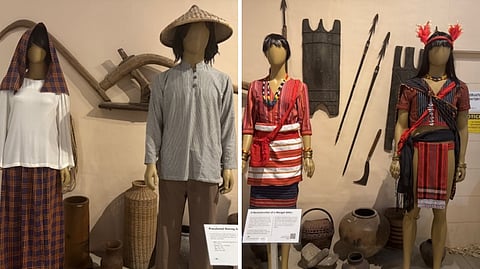On a quiet stretch of Rizal Street in Tuguegarao City stands an institution where the past is preserved and history breathes — the Cagayan Museum and Historical Research Center. More than just a repository of artifacts, it is a cultural time capsule that invites visitors to step into the stories, struggles and triumphs of the Cagayan Valley.
From tribunal to timekeeper
The museum itself is housed in a building with its own storied past. Originally the Spanish-era Casa Tribunal of Tuguegarao, it later served as the Old Cagayan Provincial Jail — its walls witnessing centuries of justice, governance, and change. In 1973, under the vision of then-Governor Teresa J. Dupaya, it was transformed into a museum dedicated to safeguarding the region’s rich heritage.
In 2018, during the administration of Governor Manuel N. Mamba, the museum relocated from the Cagayan Capitol grounds to its present, more accessible location — ensuring that more people could discover the province’s history firsthand.
A tapestry of millennia
The Cagayan Museum is more than an exhibition space — it is a timeline etched in stone, shell, pottery, and memory. Its collections stretch back hundreds of thousands of years, tracing the evolution of life and civilization in the Cagayan Valley.
The great Ice Age giants
Half a million years ago, the valley was home to colossal creatures — rhinoceroses, elephants and giant tortoises — whose fossilized remains have been unearthed in Enrile, Solana, Tuao, and Rizal. Stone tools found alongside these fossils provide indirect evidence of early humans inhabiting the area.
Paleolithic legacy
Archaeological excavations led by the National Museum and international scientists have revealed over 160 Paleolithic sites across Solana and Peñablanca. In the Callao limestone formation alone, researchers found stone tools, bones and shells in 78 caves and rock shelters — pushing back Philippine prehistory to 500,000–700,000 years ago.
These earliest settlers were hunter-gatherers, using caves as shelter, ritual spaces, and burial grounds. The Cagayan Valley Paleolithic Sites are now shortlisted for UNESCO World Heritage recognition.
Age of pottery and trade
By around 2000 BP (Before Present), Cagayan Valley communities had begun cultivating crops and domesticating animals. Pottery making became highly sophisticated, with rice husks used to strengthen clay. Along the banks of Aparri, Lal-lo, Camalaniugan and Gattaran, shell midden sites — massive heaps of discarded shells — hint at the thriving riverine life and early trade networks.
The Lal-lo shell middens are among the largest in Southeast Asia, yielding pottery sherds, polished stone tools, shell beads and, later, Chinese porcelain and trade ceramics — evidence of dynamic maritime connections with other Southeast Asian cultures.
Stories worn and woven
The museum also showcases reconstructions of pre-colonial Ibanag adornments —necklaces, bracelets, and precious stones, each carrying symbolic meaning.
Shellfish ornaments, jade beads and colorful glasswork reflect not only artistry but also trade and cultural exchange with neighboring groups like the Kalinga.
The Mengal attire, worn by an elite warrior class, is recreated with intricate textiles, traditional tattoos and feathered headdresses made from the omen-bearing Black-naped Oriole.
This reconstruction tells of a time when status, valor and spirituality were woven — sometimes literally — into the fabric of daily life.
Indigenous identities
Cagayan remains home to three distinct Negrito groups: the Isgiran Atta, Labin Agta and Dupaningan Agta.
Believed to be descendants of the first anatomically modern humans who migrated from Africa 50,000 years ago, these communities have preserved unique ethnic identities despite centuries of change.
The museum’s exhibits give space to their voices, traditions and ancestral lands.
Islands of ancestors
One of the museum’s most striking artifacts is the Fuga Island Neolithic Burial Jar (200 BC–100 AD), discovered in an indigenous cemetery alongside human and animal remains.
Similar jars have been found on other northern islands, linking the Cagayan Valley to the Austronesian migrations that began in Taiwan and spread across the Pacific and Indian Oceans.
Colonial conquests and cultural crossroads
The Spanish arrival in the late 16th century reshaped Cagayan’s political and spiritual landscape. The establishment of Ciudad de Nueva Segovia in Lal-lo in 1581 made it one of the earliest Spanish cities in the Philippines.
From here, Christianity spread throughout the valley, and the Ibanag language became the region’s lingua franca, gradually replacing other native tongues like Irraya.
Nueva Segovia’s first bishop, Miguel de Benavides, would go on to found the University of Santo Tomas — the oldest existing university in Asia.
By 1758, the diocese was moved to Vigan, but Lal-lo retained its deep historical and ecclesiastical roots.
A living chronicle
Today, the Cagayan Museum and Historical Research Center is not simply a keeper of relics; it is a storyteller, educator, and cultural guardian.
From Ice Age fossils to colonial manuscripts, from indigenous artistry to maritime trade routes, it offers a panoramic view of Cagayan’s journey through time.
For visitors — whether historians, students, or curious travelers — it is an unmissable destination in Tuguegarao, offering not just artifacts to admire but connections to understand, cultures to respect, and histories to honor.
Because here, in the heart of Cagayan, the past is not forgotten — it is kept alive, waiting to be discovered again.


